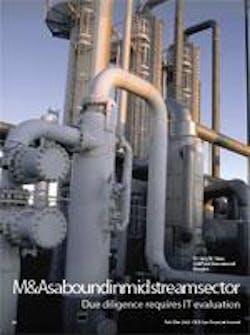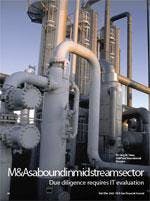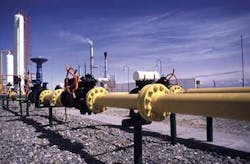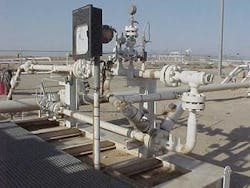M&As abound in midstream sector
Dr. Gary M. Vasey
UtiliPoint International
Houston
The midstream oil and gas business in North American is currently undergoing significant change and turmoil. Over the past 24 months, there has been a notable increase in the pace of mergers and acquisitions of midstream assets such as gathering systems, gas processing plants, and pipelines, which accounts for much of the commotion. Some recent examples of this activity include:
• The acquisition of the Texas Chalk and Madison Systems from Devon Energy Corporation by Energy Transfer Partners, L.P. ($65 million);
• Regency Gas Services’ purchase of natural gas treating facilities in Texas and Louisiana from Cardinal Gas Services ($3.4 million);
• Regency’s acquisition of gathering, processing, and treatment facilities in West Texas from Duke Energy Field Services ($62 million);
• Regency’s purchase of gathering and processing assets from El Paso Corporation ($120 million);
• Sago Energy’s sale of its Texas and Louisiana subsidiaries to WTG Gas Processing, LP, that it had acquired earlier from Devon (amount undisclosed);
• The acquisition of refined petroleum pipelines from affiliates of Shell Oil Products by Magellan Midstream Partners, LP (amount not known);
• Targa Resources’ acquisition of midstream assets from ConocoPhillips and an interest in Bridgeline Holdings (undisclosed);
• Enbridge’s acquisition of Shell’s pipeline network in the Gulf of Mexico ($613 million);
• Loews Corporation’s acquisition of Gulf South Pipeline from Entergy-Koch ($1.14 billion); and
• The acquisition of the LIG Pipeline and other assets from AEP by Crosstex Energy, LP ($76 million).
What's driving the activity?
This flurry of activity can be attributed, at least in part, to the demise of the mega-merchants. The collapse of the merchant energy business has had a domino effect, causing many energy entities to divest significant and often attractive physical assets to generate urgently needed cash.
Indeed, the collapse of the mega-merchants has created a ripple effect through the entire industry in the form of increased stakeholder scrutiny of corporate financials, new regulation, and an emphasis on credit management and credit risk. In turn, these pressures have forced many larger energy companies to seek to clean up their balance sheets. This industry introspection is often the basis for the sale of assets that are very attractive to others.
Similarly, a renewed focus on portfolio optimization, rationalization of business strategies, and a return to the concept of a core business among large E&P, utilities and integrated energy companies is also driving some of the acquisition and divestment activity. The continuing adjustment of asset portfolios and business models is resulting in physical midstream assets changing hands, as well as allowing new, non-traditional players (such as energy hedge funds, investment banks, and master limited partnership vehicles) to enter the market by capitalizing upon attractive acquisition opportunities.
The acquired midstream and pipeline assets are generally of good quality and are attractive cash generators and often, they also bring with them experienced staffs and the expertise to manage the assets effectively. Overall, investors appear to be warming to the midstream sector, as it offers good assets at attractive prices and often includes effective asset managers. Funding is more readily available for this type of investment than it has been in the past.
One interesting aspect of this furious pace of transactions is the players involved. On the buy side, non-traditional players such as investment banks, private investment firms, financial and insurance firms, private equity, and hedge funds all have acquired midstream assets.
For example Hicks, Muse, Tate & Furst, a private investment firm, recently purchased Regency Gas Services. Warburg Pincus provided seed funding for Targa Resources, Inc., a midstream start-up; and Loews Corporation acquired Gulf South Pipeline, LP, from Entergy-Koch.
In addition, hedge funds have been in the news recently as significant new shareholders in energy corporations such as British Energy and Aquila, Inc. Today, hedge funds are among the largest providers of debt financing to what is left of the energy merchant sector of the industry and have also been involved in acquiring those companies’ valuable assets, often at fire-sale prices.
Over the last year, publicly traded master limited partnerships (MLPs) emerged as one of the leading vehicles of choice for many of the acquisitions and mergers. MLPs have two major advantages over other corporations that make them attractive in today’s environment:
1) MLP earnings are taxed only once at the unit holder level. Most other publicly traded corporations are actually taxed twice - once at the corporate level and once at the shareholder level. Therefore, MLPs can pay out significantly more of their cash flow to unit holders than an ordinary corporation.
2) The non-tax expenses of an MLP, such as depreciation, directly benefit the unit holder since such expenses diminish the taxable income passed through to unit holders.
Created by Congress in the 1980s to stimulate oil and gas exploration, the MLP corporate structure was designed to allow energy companies to spin off production and transportation assets into separately managed MLPs. By spinning off the MLP, the energy company raises cash to pay down debt or invest in other businesses.
While midstream assets may be considered to be primarily a slow growth but steady cash-flow business, by packaging such assets into an MLP, the entity can pay out all earnings to unit holders and pay no taxes on those earnings. Essentially, companies can sell such midstream assets to investors for a market price in return for a promise to pay out the cash flow after maintenance expenses, while maintaining control.
Recently, M&A activity has also occurred as a result of the expansion of MLP ownership of assets. By increasing the asset-base, the MLP can operate more efficiently and generate more income for unit holders. So MLPs are now in acquisition mode, aggressively seeking to aggregate and consolidate similar assets.
MLPs are generating between six to eight percent returns for investors, which is well above returns on more traditional investments. MLPs provide investors with a useful and attractive vehicle for the acquisition of assets in the midstream energy industry.
The IT factor
While acquired assets often bring with them experienced staffs to manage them effectively, there are other critical considerations that need to be made. Any party participating in the acquisition or divestiture of an asset undertakes a significant due diligence process.
Most often, the primary focus of due diligence activity is on the financial and operational health of the assets. However, in today’s business environment, it is critical that the back-office functions, processes, and systems play a more prominent role in these due diligence activities.
The back-office functions, processes, and systems - consisting of contracts, allocations, settlement, invoicing, and accounting - have become more important as a result of industry events. For example, recent regulation and industry dynamics have created a new set of issues associated with Sarbanes-Oxley compliance and environmental compliance concerns.
Additionally, sellers who cannot adequately demonstrate and document an organized and comprehensive back-office infrastructure designed to manage these issues will likely raise doubts or concerns with the prospective buyer. A possible result may be an adverse effect on the final selling price of the assets.
IT considerations should be a crucial part of the due diligence process, according to Cleve Hogarth, vice president of Houston-based Quorum Business Solutions, a software development and IT consulting firm with experience in the midstream sector.
“From various projects we’ve been involved in, we’ve seen incidences where companies go through a thorough evaluation of the physical and financial assets during the due diligence process, but fail to include IT considerations,” said Hogarth. “In some cases, this derails the initiative, or at least the project is delayed.”
Back-office dilemma
For the buyer of an asset such as a gathering system or a gas processing plant, the back office consideration should provoke a set of important decisions. While the physical configuration, business model, and tariff scheme should be evaluated for each asset on an as-is basis, the acquirer actually has a number of choices it can make with respect to the back-office systems (assuming the acquirer already operates other similar assets), as follows:
1) Operate the asset to be acquired independently using the existing legacy back-office systems for that asset (assuming rights to the back-office system can be acquired along with the physical assets).
2) Utilize the back-office systems already in use by the acquiring entity for its existing assets.
3) Build a new system to operate the new asset on either a stand-alone basis, or integrated with other existing assets.
4) Acquire a new commercial system to operate the new asset on either a stand-alone basis, or integrated with other existing assets.
Since most legacy in-house developed systems were designed for a specific asset and lack the built-in flexibility and configurability to be utilized more broadly, most often such legacy systems are not well suited to expanded deployment to support multiple assets and business approaches. This may lead the acquirer to consider implementing a new system specifically for the acquired asset.
Unfortunately, this approach brings with it the associated costs of maintaining and managing two or more sets of incompatible back-office systems and missing the opportunities and benefits realized from an integrated back-office system.
Additionally, given the new regulatory environment and the focus on corporate governance, the existing legacy system associated with the acquired asset may fall short, requiring additional incremental investments. But historically, enhancing legacy systems has proven both difficult and costly. Further, the acquirer is not only seeking to ensure compliance with new regulations but to also optimize the asset for incremental margin. In short, legacy systems add no value and are a less-than-ideal choice.
Given high enhancement and maintenance costs of legacy systems, the time of acquisition of an asset may be the best opportunity to replace such older systems with software that both meets new regulatory requirements and provides the basis for optimizing business processes. While replacement can actually be a more cost-effective option than enhancement, it almost always represents a more effective method by which to reduce total cost of ownership expenses.
Quorum’s Hogarth agrees. “While improving operational efficiencies usually tops the list of acquisition objectives, even today, many companies still rely on spreadsheets or outdated, internally developed solutions to manage their assets and related data. From our experience, upgrading the IT infrastructure of the newly acquired assets certainly improves overall efficiency and also leads to higher profit margins.”
Conclusions
M&A activity in the midstream energy sector is now attracting money from new buyers such as MLPs, private equity firms, investment banks, and hedge funds. MLPs represent an opportunity to obtain better-than-average returns and are tax advantaged.
As a result of the collapse of the mega-merchants and subsequent fallout, sales of gas processing plant and gathering facilities represent an opportunity to generate cash for sellers and a chance to obtain reasonable and attractive returns for buyers. With more investment money available, the M&A activity in the midstream industry is likely to continue at a reasonable clip for some time to come.
For those acquiring these assets, new regulations and an increase in corporate scrutiny mean that the due diligence process should carefully evaluate the systems used in the day-to-day operation of the assets because these back-office systems are the architecture on which the assets generate and account for revenues and earnings.OGFJ
The author
Gary M. Vasey [[email protected]] serves as vice president for UtiliPoint International’s trading and risk management practice. He has industry experience with BP Exploration; Price Waterhouse; Cap Gemini Sogeti; Sybase; and TransEnergy Management. He holds a Ph.D. in geology from the University of Strathclyde in Glasgow, Scotland.





